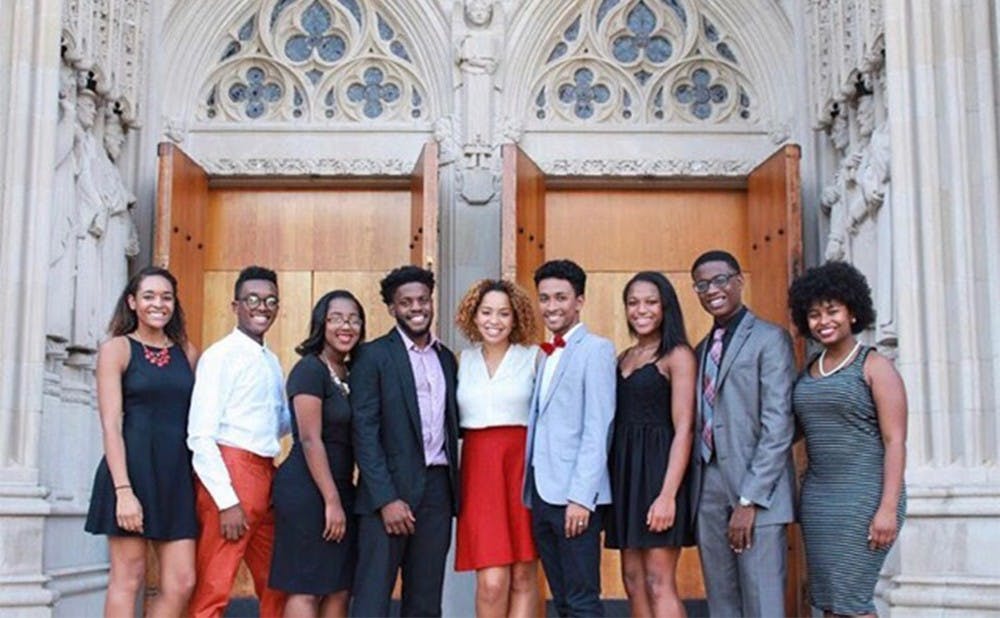For 50 years, the Black Student Alliance has been a central actor in Duke's history.
Founded in 1967 as the Afro-American Society, the organization has had five decades of experience advocating for black students at Duke. In recent years, the group has mounted responses to several incidents on campus, including the discovery of a noose near the Bryan Plaza and the defacement of a #BlackLivesMatter poster with a racist slur. But the organization seeks to do more than respond, said current BSA president Tiana Horn, a senior.
"We are basically a service organization to uplift students of color and educate other students about black culture, black history and everything that goes along with that,” she said.
Troy Clair, Trinity '02, was president of BSA during his junior year. Clair, who is currently Chief of Staff for U.S. Rep. G.K. Butterfield, said that BSA has always worked to improve the lives of all students through the advancement of black students. However, he also noted that the role of BSA is different each year because of the ever-changing circumstances of the black community at Duke.
To chronicle the whole history of BSA would be too immense a task, but several key moments mark its influence on the University.
Until 1967, student organizations, faculty and administrators—including then-President Douglas Knight—were members of the Hope Valley Country Club, a segregated facility. In response, AAS embarked on a student-led “study-in” that November in an attempt to prevent the University community from patronizing such facilities.
“It is one thing for the Administration of this institution to say that we accept our Negro students here at the University on the same basis that we do other students, and quite another to smack us in the face by indicating in your private lives that you will not treat Negroes equally with others,” wrote AAS students in an open letter in The Chronicle. “The two are directly contradictory and must be considered irreconcilable.”
Three days later, the University amended its policies to prohibit the use of segregated facilities.
In 1969, approximately 75 AAS students occupied the Allen Building, renaming it “The Malcolm X Liberation School.” The group had 13 demands, which included an African American studies program, a black dormitory and improved working conditions for University staff.
The takeover ended several hours after it began. Students outside the building, who were there in support of their black peers, were met with police action and were tear gassed. None of the students involved in the protest were expelled, but many were put on probation. Administrators met some of the students' demands, though there was ongoing debate about whether the response was adequate.
“It was struggle that brought the concessions—not any of Knight’s bull about 'rational discourse,'” one AAS document stated. “Without a building occupation, without students fighting cops, without a partially successful strike, without a massive, potentially militant march—and, especially, without a threat of more militant struggle in the future—this victory would never have been won. The administration/trustees never give major concessions until they are forced to. This is a major lesson we learned.”
In 1971, AAS was renamed Association of African Students and then in 1976, was again renamed the Black Student Alliance. During the 1980s, BSA worked with the administration to increase black student enrollment and helped create the Black Student Alliance Invitational and the Regional Howard Scholarship, named in honor of the first black student to become president of the student government in 1976.
The group's priorities evolved again in the late 1990s and early 2000s. Clair noted that BSA focused on ensuring greater equity in student housing options during his time as president.
Damani Sims, Trinity '00 and BSA's president during his senior year, said the group worked to increase the number of black faculty members. BSA also sought to loosen a requirement that security guards be present at events run by black sororities and fraternities.
“For my time and my presidency, one of the roles I envisioned for [BSA] was continuing the legacy, but also being practical with the implementation of our goals and our programs,” Sims said.
Sims added that issues facing BSA are more “nuanced” and that he hopes BSA is addressing concerns that affect its LGBTQ+ members and students who come from low-income backgrounds.
This year, BSA has sought to make Counseling and Psychological Services more accessible to black students, Horn said. They have also been working to provide relief for Flint, Mich. and are preparing for incoming President Vincent Price's role in the administration.
"In general, the administration definitely sees the importance of our organization and the role it plays in the lives of students here," Horn said. "We have a closer relationship with the administration than a lot of organizations do because we are constantly asking them things and are trying to make Duke better for our constituents and students, in general.”
Get The Chronicle straight to your inbox
Signup for our weekly newsletter. Cancel at any time.
Class of 2019
Editor-in-chief 2017-18,
Local and national news department head 2016-17
Born in Hyderabad, India, Likhitha Butchireddygari moved to Baltimore at a young age. She is pursuing a Program II major entitled "Digital Democracy and Data" about the future of the American democracy.

